

Water crisis: Pakistan running dry by 2025, says study. Connecting the dots: climate change, WPS and youth. India’s surging economy could doom climate efforts—unless richer nations step up. Democracy Ranking 2016 – Democracy Ranking. The Carbon Brief Profile: India. Viewing Chinese foreign policy through the lens of the Chinese classics – Asia Dialogue. Water crisis: Pakistan running dry by 2025, says study. China’s Grand Idea For The 21st Century: Will The New Silk Road Transform Global Health Assistance? The New Silk Road: Its very name harkens the distant past, conjuring whatever the imagination might bequeath, of empires and riches of a mythic past. China’s grand idea for the 21st century would connect Africa, Asia, and Europe through cyberspace and physical space, promising prosperity and innovation. One Belt, One Road, or Belt and Road, pledges a massive $1 trillion infrastructure investment in roads, ports, energy, and telecommunications, a bold vision for economic development.
Will the benefits of One Belt, One Road be widely shared or flow mostly to China? Bangladesh signs US$13.6bn investment package with China. On October 14th-15th China's president, Xi Jinping, visited Bangladesh as part of his regional tour of Asia.
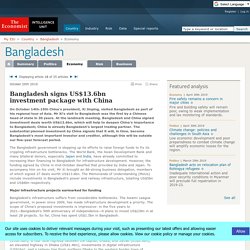
Mr Xi's visit to Bangladesh was the first by a Chinese head of state in 30 years. At the landmark meeting, Bangladesh and China signed investment deals worth US$13.6bn, which will help to deepen China's importance to Bangladesh; China is already Bangladesh's largest trading partner. Research Presents Road Map for Agriculture as Nepal Adopts Federalism. Adjusting Nepal’s complex agricultural economy to the federalist system laid out by the new constitution will require some adjustment, but a new paper from the International Food Policy Research Institute (IFPRI) proposes several policy measures to ease the transition.

Sri Lanka on path to 100% renewable energy says a new joint report by UNDP and ADB. Aug 16, 2017 New York, 16 Aug - Sri Lanka can meet its current and future electricity demand by judicial use of renewable energy by 2050, according to a joint study by the UN Development Programme (UNDP) and Asian Development Bank (ADB).
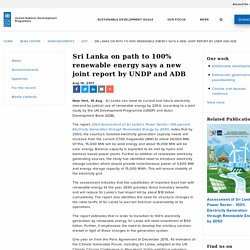
The report, titled Assessment of Sri Lanka’s Power Sector—100 percent Electricity Generation through Renewable Energy by 2050, notes that by 2050, the country’s installed electricity generation capacity needs will increase from the current 3,700 megawatts (MW) to about 34,000 MW. Of this, 15,000 MW will be wind energy and about 16,000 MW will be solar energy.
Balance capacity is expected to be met by hydro and biomass based power plants. Further to addition of renewable electricity generating sources, the study has identified need to introduce electricity storage solution which should provide instantaneous power of 3,600 MW and energy storage capacity of 15,000 MWh. Sri Lanka, Struggling With Debt, Hands a Major Port to China. Is India the frontline in big tech’s assault on democracy? In 10 days’ time, two political dramas will reach their denouement, thanks to the votes of a combined total of about 1.3 billion people.

Armed militants storm luxury hotel in Pakistan attack. At least three armed militants have stormed a luxury hotel in Pakistan and exchanged fire with government forces.

Local media said the fighters stormed the Pearl Continental hotel in Gwadar just before 5pm local time on Saturday. What does Narendra Modi’s landslide win mean for Nepal? May 23, 2019- With the reelection of the Bharatiya Janata Party and Prime Minister Narendra Modi in neighbouring India, Kathmandu’s diplomatic and political circles are certain to spend the coming weeks parsing what this could mean for Nepal.

Discourse in Kathmandu is likely to centre on the future of Nepal-India ties, India’s neighbourhood policy, and Kathmandu’s attempts at striking a geopolitical balance, especially given increasing major power maneuvers in the region, according to foreign affairs experts and former diplomats. Significance of Shanghai Co-operation Organization and Nepal. The eight-member, four observers and 6 dialogue partners including Nepal with four guests attendances; the Shanghai Co-operation Organization (SCO) summit is being held on June 13th and 14th in Bishkek, Kyrgyzstan.

The permanent secretariat of SCO is seated in Beijing and a security outpost in Tashkent. The guests to attend the SCO include the Association of South East Asian Nations (ASEAN), Commonwealth and the Independent States (CIS), the United Nations and Turkmenistan. SCO began its journey as Shanghai Five in 1996, later christened into Shanghai six in 2001 and finally converting it into SCO in 15th June 2001. The charter of SCO was signed in June 2002 which entered into force in September 2003.
Though it started as a Eurasian political, economic and security alliances, the organization has given a different geo-political semblance after India and Pakistan became its members in 2017 making it a trans-regional forum. Nepal is looking for more investment from China. India Overestimated Economy GDP Growth From 2011-17: Study. India’s statistics may have been painting a far rosier picture of economic growth than the more modest reality of the past decade.
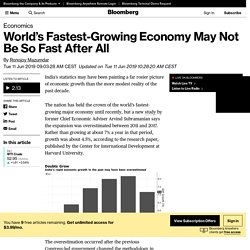
The nation has held the crown of the world’s fastest-growing major economy until recently, but a new study by former Chief Economic Adviser Arvind Subramanian says the expansion was overestimated between 2011 and 2017. Rather than growing at about 7% a year in that period, growth was about 4.5%, according to the research paper, published by the Center for International Development at Harvard University. The overestimation occurred after the previous Congress-led government changed the methodology in calculating gross domestic product in 2012. Forestsnews.cifor. Himalayan glacier melting doubled since 2000, spy satellites show.
The melting of Himalayan glaciers has doubled since the turn of the century, with more than a quarter of all ice lost over the last four decades, scientists have revealed.
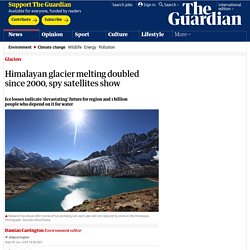
The accelerating losses indicate a “devastating” future for the region, upon which a billion people depend for regular water. The scientists combined declassified US spy satellite images from the mid-1970s with modern satellite data to create the first detailed, four-decade record of ice along the 2,000km (1,200-mile) mountain chain. The analysis shows that 8bn tonnes of ice are being lost every year and not replaced by snow, with the lower level glaciers shrinking in height by 5 meters annually. The study shows that only global heating caused by human activities can explain the heavy melting. In previous work, local weather and the impact of air pollution had complicated the picture. Jugaad. A temporary jugaad improvised repair for a broken support Jugaad (alternatively Juggaar or Jugar) is a colloquial Hindi (Devanagari: जुगाड़), Bengali (যোগাড়), Marathi जुगाड, Punjabi and Urdu (جگاڑ) word, which has various meanings depending on the situation.
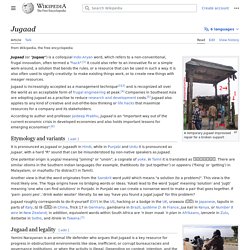
In Tamil it is translated as உத்தரம், Roughly translated, jugaar is a "hack".[1] It could also refer to an innovative fix or a simple work-around, a solution that bends the rules, or a resource that can be used in such a way. It is also often used to signify creativity: to make existing things work, or to create new things with meager resources. According to author and professor Jaideep Prabhu, jugaad is an "important way out of the current economic crisis in developed economies and also holds important lessons for emerging economies".[5]
Are parts of India becoming too hot for humans? Heat waves in India usually take place between March and July and abate once the monsoon rains arrive. But in recent years these hot spells have become more intense, more frequent and longer. India is among the countries expected to be worst affected by the impacts of climate crisis, according to the Intergovernmental Panel on Climate Change (IPCC). Experts at the Massachusetts Institute of Technology (MIT) say that even if the world succeeds in cutting carbon emissions, limiting the predicted rise in average global temperatures, parts of India will become so hot they will test the limits of human survivability. "The future of heat waves is looking worse even with significant mitigation of climate change, and much worse without mitigation," said Elfatih Eltahir, a professor of hydrology and climate at MIT. When the heat rises Last year, there were 484 official heat waves across India, up from 21 in 2010.
As Tensions Rise Between India and the US, Are We Reaching a Point of No Return? – Brink – The Edge of Risk. The South Asian monsoon, past, present and future - A gamble on the rains. A growing presence: India in Africa 2019-07-31. India is no longer the world’s fastest-growing major economy. Was it ever? How BJP is proposing to change Jammu & Kashmir and what that means - The Record. Hats off to the creator of this video.. The entire history of our civilization in 5 mins. And we are only taught of Mughals in our history books... How India’s Article 370 has remade regional politics - Khabarhub English News Khabarhub English News. On 5th August, a historic day for the Government of India made Article 370 redundant, scraped Article 35A and bifurcate the preceding state of Jammu and Kashmir (J&K) into two Union Territories (UT).
The endorsement by President Ram Nath Kovind on the bold decision by PM Modi is fundamental for the commencement for peace and prosperity or provokes conflict in diverse forms that will invite major powers involvement. The major two powers China and India and three nuclear states China, India, and Pakistan once again have appeared illustrious with China’s further enthusiastic involvement in the South Asian region. The Silence Is the Loudest Sound. He didn’t explain why Kashmiris needed to be locked down and put under a communications blockade while he delivered his stirring speech.
He didn’t explain why the decision that supposedly benefited them so hugely was taken without consulting them. How India’s removal of Article 370 has remade regional politics - Khabarhub English News Khabarhub English News. The west’s custodians of democracy failed to notice it rotting away. A blueprint for consolidating power: China exports Xi Jinping Thought to Nepal. China’s President Xi Jinping may be visiting Nepal next month, but his doctrine, widely known as Xi Jinping Thought, arrived a month earlier in Kathmandu, bundled as a two-day symposium for top leaders of the ruling party.
On the boil: India, Pakistan and China 2019-10-12. The Come Back Of China In South Asia. China is constructing a land bridge to the Indian Ocean, while the US competence to persuade the power balance in South Asia is declining. EPRS STU(2017)603263 EN. India's economy to be world's No.3 by 2028: forecast. TOKYO -- India and key Association of Southeast Asian Nations members will become increasingly vital drivers of Asian growth over the coming decade, while China's economy slows to a pace comparable with the U.S., new projections from the Japan Center for Economic Research show.
India's gross domestic product is likely to top $6 trillion by 2028, overtaking Japan as the world's third-largest economy. The center on Tuesday released its third Medium-Term Asian Economic Forecast for 2017 through 2030. The report, titled "Digital Asia 5.0 -- Innovation changes economic power relationship," puts the Philippines on track to log 6.4% real GDP growth in 2030, with India expected to post a 5.2% rate and Vietnam likely to record 5% expansion that year. UK could remain a top 10 global economy in 2050, despite Brexit. Bangladesh inks MOU with Indonesia for LNG supplies.
Bangladesh inked a memorandum of understanding Friday for LNG imports from Indonesia, an official at Bangladesh's Ministry of Power, Energy and Mineral Resources said Friday, as the country continues to seek out supplies to meet mounting domestic demand. Transboundary Waters Archives - The Asia Foundation. The Urgency Of Electric Vehicle Policy And Infrastructures In Nepal. 4406 Embracing the BRI ecosystem. Important Business News 27th May, 2018 - Faisalabad Chamber of Commerece & Industry. The idea of Eurasia is once again the subject of geopolitics - Banyan. China’s Diplomatic Moves Amidst the India-Pakistan Conflict. EC R&I Natural Agenda - India + - Google Sheets.
Bicycles can boost Bangladesh's exports. Pakistan on track to become emerging economy in 2018. China Steps Into the Middle East Maelstrom. Is Coal in China Dead? - IER. SOUTHASIA. The many challenges awaiting Pakistan's Imran Khan. Middle East powers seek ties with China. Chabahar Port: building a gateway to prosperity in south-eastern Iran. Karachi to become the world’s third most populated city by 2030 - Samaa Digital. How Asia's startups drive digital disruption. Bond yields on the Colombo Stock Exchange expected to be bullish over medium term. 9 questions about climate change you were too embarrassed to ask. E3G Briefing Sustainable Infrastructure.
Climate change threatens lives and futures of over 19 million children in Bangladesh. India’s surging economy could doom climate efforts—unless richer nations step up. EPRS STU(2017)603263 EN. Climate Change in Nepal: Impacts and Adaptive Strategies. 'Global warming pose risk of cholera outbreak in Bangladesh' How dire climate displacement warnings are becoming a reality in Bangladesh. Why ‘Digital India’ remains a distant dream. India - Energy.